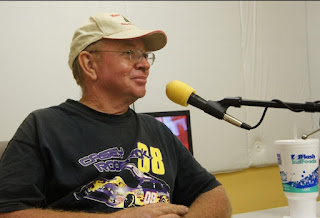The Rest Of The Story
It makes me feel really old to be writing about something that happened 50 years ago, but here goes anyway.
Back in 1973, I went to many a race with a group of men from
my hometown of Inman and thereabouts. Most of them are gone now. My distant
cousins, Wesley, Weldon and Ronnie Stubbs were regulars in our group, as were
Freeman Clemons and Pete Gay.
Cecil Dunn went occasionally, and it’s refreshing that his
memory of the things we saw back then matches up with mine. Cecil and I were
standing next to the backstretch fence in 1975 when Tiny Lund was killed in a
crash just in front of us. We also watched as two Georgia men, watching from
the infield across from us, scaled the fence and rescued Terry Link from his
burning car, even as a track worker was using his caution flag as a weapon to
try to keep the two heroes away from Link’s car, which had impacted Lund’s.
(Years later, thanks to a savvy researcher at the newspaper, I was able to
interview Richard Simpson and David Garmany, both of whom were burned in the
rescue.)
All of our trips to Talladega, where NASCAR is racing
this weekend, were memorable, some more than others.
The 1973 Talladega 500 featured a tragedy in the
beginning, and odd occurrence in the middle and a fairy tale finish at the end.
Larry Smith hit the wall in Turn One just as the race
was getting going, contact that appeared minor from our seats on the backstretch.
We eventually learned that Smith had been killed.
Then Bobby Isaac suddenly
retired from the race. Later we heard that Isaac heard voices telling him to
quit.
If that wasn’t enough,
the finish turned out to be the what many say is the biggest upset in NASCAR
history.
Like many of the folks
from the Atlanta area who were at Talladega that day, my friends and I were
closely watching the car owned by Jimmy and Peter Crawford, two Eastern Air
Lines pilots from College Park.
It was a 1972 Plymouth, painted in the black and gold colors
and carrying the No. 22 made famous by the late Fireball Roberts.
Jimmy, often the
driver, had been discouraged by NASCAR from driving in the race because of a
crash in his previous Talladega appearance. So a deal was worked for journeyman
Dick Brooks to take the wheel.
It was apparent from
the start that Brooks’ machine was a fast one. Several times we saw him drop to
the inside of the long backstretch and blow by a string of cars like the rude
motorist who ignores the “Left Lane Closed Ahead” signs on the highway and
speeds by the slowing motorists in the right lane before darting in front just
as his lane closes.
Brooks needed the
straightaway speed because the car was a clunker in the corners, and his pit
crew, a rag-tag bunch of amateurs, lost him a lap or so on most stops.
Brooks led four times
for 19 laps, including the one that counted.
Not long afterward,
the Crawfords dropped off the NASCAR circuit and were largely forgotten.
But one night in the late 1980s, in the pits at
Senoia, Jimmy and I started talking about the Talladega win, and that’s when I
learned the real story behind the Crawfords’ upset victory.
The win, it seems, wasn’t so
unlikely after all. The Plymouth had been built originally by Mario Rossi, one
of the top mechanics of his era. But the real secret to the speed was under the
big black hood, the area where Peter Crawford worked his magic.
Peter Crawford, it turned
out, was a mechanical genius. With NASCAR forcing the big-block engines of
that era to run restrictor plates, Crawford set about to design an induction
system that would maximize the air flow to his engine despite the plate.
He wound up designing his own
intake manifold, which he built according to the specifications in the rule
book. He submitted it to NASCAR, and it was approved, as long as he made
similar manifolds available to the other Plymouth teams, which he did.
What NASCAR officials didn’t
realize at the time was the effectiveness of Crawford’s creation. When the
power plant was hooked to a dynamometer at an Atlanta-area race shop, the
engine produced more power than the dyno could measure. So Crawford made his
own dyno. Even with the restrictor plate attached, the engine cranked out far
in excess of 600 horsepower, a whopping amount for that time.
So it was really no surprise
that Brooks was able to run so fast on the straightaways, especially since the
brothers had also used their aerodynamic knowledge to tweak the body. And this
was in the days before trips to wind tunnels were commonplace.
The win wasn’t just a
surprise to the fans in the stands that day, it was something that NASCAR
founder and track owner Bill France Sr. didn’t expect – or appreciate.
According to the Crawfords,
France summoned them to NASCAR headquarters in Daytona Beach for a meeting,
where he informed Peter that his manifold was being outlawed.
Peter protested, saying his
creation fit every spec in the rule book.
France, he said, responded
that it didn’t.
Crawford said he
respectfully asked France to show him where he was in violation.
According to Crawford,
France had him turn the rule book from the engine specs back toward the front
of the book. He had him read the opening sentence.
It read: “All parts must be
NASCAR approved.”
That was his violation, and
with that ruling, one of the slickest parts ever run in NASCAR was never seen
at the track again.



Comments
Post a Comment